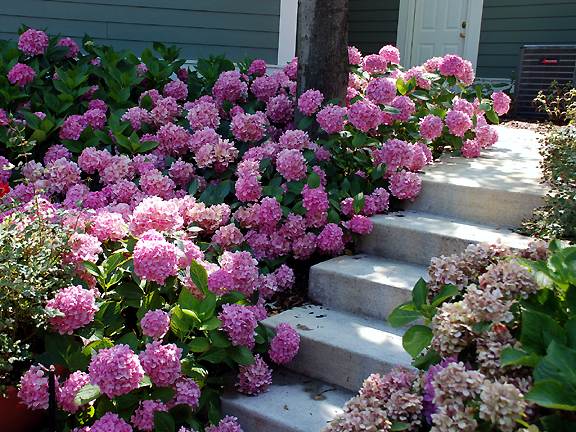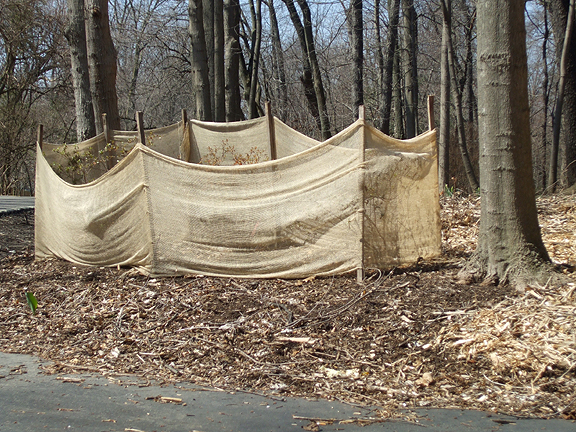Garden Faerie: Protect mophead and lacecap hydrangeas

Mophead hydrangeas (such as 'Let's Dance® Moonlight') will provide a lot of large blooms next season if given winter protection now.
Photo courtesy of Proven Winners
Now is a great time to add winter protection to certain types of hydrangeas. Mophead/bigleaf and lacecap hydrangeas will produce more blooms next year if you shelter them from extreme wind and cold.
Cash left the following comment in response to one of my recent posts:
"Due to the mild winter last season, I had blossoms on my big leaf mop head hydrangeas this year for the first time in at least 10-15 years."
This is an excellent and timely observation. This season, many other mophead (also called bigleaf) and lacecap hydrangea growers also reported having more flower blooms than normal, without doing anything different from normal. That's because last winter was a bit milder than usual.
If you want to see more blooms on a regular basis, you just need to provide a little winter protection for any Hydrangea macrophylla, commonly called mophead or bigleaf hydrangeas, and Hydrangea serrata, commonly called lacecap or mountain hydrangeas.â€
Common mophead/bigleaf cultivars include 'Endless Summer,' 'Nikko Blue,' 'Penny Mac' and 'Pia.' Common lacecap cultivars include 'Blue Billow,' 'Bluebird,' 'Little Geisha' and 'Wilson 7820.'
Tip: If you're not sure what kind of hydrangea you have, click here.

Mophead/bigleaf and lacecap hydrageas benefit from burlap staking and leaf mulching.
Photo by Jo Ellen Meyers Sharp of Hoosier Gardener
Note: These other types of hydrangeas do not need winter protection to bloom profusely: oakleaf hydrangeas (Hydrangea quercifolia), Annabelle-type hydrangeas (Hydrangea arborescens) or PeeGee (also called PG) hydrangeas (Hydrangea paniculata).
The tips of the branches are what require winter protection. This is where buds form by late summer and where flowers will bloom next spring. Anti-desiccant sprays are not useful here; they are used to keep the leaves of evergreen shrubs like hollies and rhododendrons from drying out, but hydrangeas drop their leaves.
Instead, metro Detroit gardening guru Janet Macunovich‡ recommends creating a chicken-wire fence or burlap screen to enclose the plant. It's important that the screen is taller than the tops of the branches to keep those branch tips warm. You can dump dried leaves inside the screen or wire enclosure (all the way to the top) to provide warmth and to keep the soil temperature a little more consistent.
Remove the wrap in spring, but have something on hand to cover the tips if a freak frost should occur.
And, as my handyman hero Red Green says, it's just that easy!
†Note for plant geeks (everyone else ignore this!): A few websites list lacecaps as H. macrophylla normalis, not H. serrata. For example, I found 'Blue Billow' listed both ways. Some scientists, botanists, and plant people insist they are separate species, while others insist that they are all H. macrophylla. Genetic testing just seems to add to the debate, and even scientific geniuses can't agree. I'm just going to go with lacecaps being H. serrata until someone official decides otherwise and issues a bulletin!
‡ To sign up for the free weekly e-newsletter What's Coming Up: Janet Macunovich & Steven Nikkila answer your growing concerns, send an email to JMaxGarden@aol.com.
____
Monica Milla, the Garden Faerie, is a master gardener volunteer, garden speaker, garden coach and author of "Fun with Winter Seed Sowing."


Comments
ssgardengirl
Mon, Nov 8, 2010 : 2:41 p.m.
Good tips Monica. I was always too lazy to bother protecting them, so they didn't bloom much. Since rabbits eat them here, I haven't been able to get any established and have about given up on growing hydrangeas, except the oakleaf which is fenced, or it too would be dead. Maybe I should thank the bunnies for eating my hydrangeas so I don't have to bother protecting them from the cold. :)
Ramon
Sun, Nov 7, 2010 : 10:01 a.m.
Good article, Monica, and I especially like the tip in the comments about the Minnesota tip. I'd read something about a similar technique but didn't know it had a name.
Cash
Thu, Nov 4, 2010 : 4:40 a.m.
I will let you know. I haven't tried to bend the branches yet...they may be too brittle. I won't uproot the plant at all. I have one mop head that has a branch laying on the ground and that branch blossoms profusely. So I'll let you know the results.
Monica Milla
Wed, Nov 3, 2010 : 6:10 p.m.
This sounds similar to the Minnesota tip method. It's used up there for roses, but according to Janet Macunovich can also be used here for mopheads: "Other gardeners do the Minnesota Tip to protect these hydrangeas. They uproot one side of the plant, tip it over and mound soil over the entire shrub. They uncover it and re-set it in early spring." I personally get skittish when I think of uprooting plants... even if the roots are covered. If you try it, let me know what happens!
Cash
Wed, Nov 3, 2010 : 5:36 p.m.
Great article, Monica. I am going to try to tip some longer branches down onto the ground(on my mop heads) and cover them and see if that works. One year I tried to cover the entire bush with leaves, encircling it with burlap, but it still didn't blossom....and I got mice! My lace cap (Blue Billows) has blossomed every year for the past 10 years without fail. But it's in a protected area. It sure does spread a lot. It's beautiful!